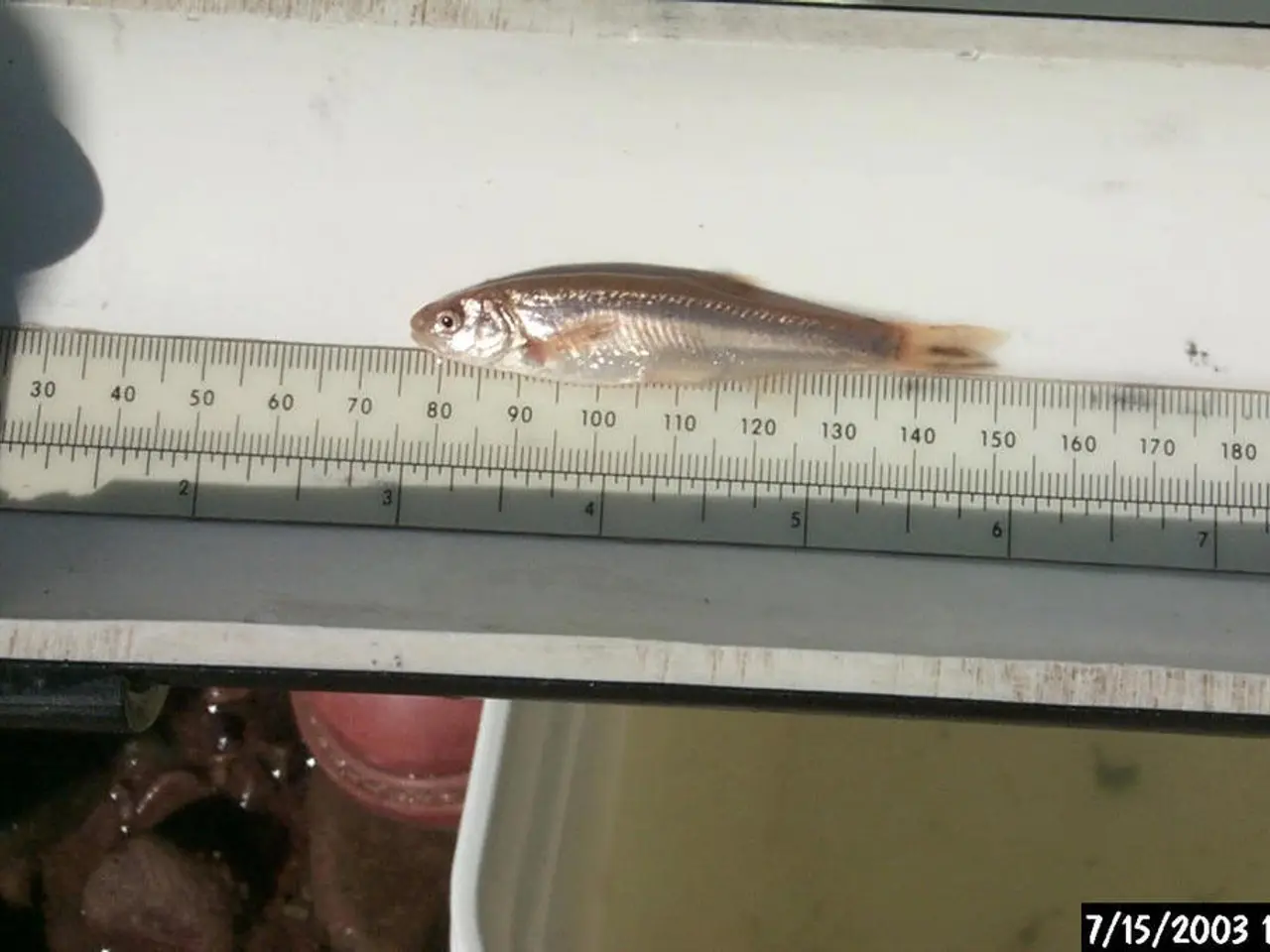Understanding when you're most fertile and calculating your ovulation cycle:
## Understanding Fertility and the Menstrual Cycle
The **fertile window**, a crucial period in a woman's menstrual cycle, is when the chances of conception are at their highest. This window typically spans six days, encompassing the five days leading up to ovulation and the day of ovulation itself [1][2].
### Phases of the Menstrual Cycle
1. **Menstrual Phase (Days 1-5)**: This is the beginning of the cycle, where the uterus sheds its lining if no pregnancy occurs. Fertility is low during this phase [3].
2. **Follicular Phase (Days 1-13 in a typical cycle)**: Hormones like estrogen and follicle-stimulating hormone (FSH) increase, preparing the body for a potential pregnancy. Fertility starts to increase as this phase progresses [1][3].
3. **Ovulation Phase (Typically Day 14)**: This is the most fertile day, as the egg is released and available for fertilization. Ovulation is triggered by a surge in luteinizing hormone (LH) [1][3].
4. **Luteal Phase (Days 15-28)**: After ovulation, hormones like progesterone support potential implantation of a fertilized egg. If no fertilization occurs, hormone levels drop, leading to menstruation [1][3].
### Factors Affecting Fertility
- **Cycle Length**: Variations in cycle length can shift the timing of ovulation and the fertile window. Cycles can range from 21 to 35 days, impacting when ovulation occurs [2].
- **Stress and Diet**: These can influence ovulation timing and hormone balance, affecting fertility [2].
- **Medical Conditions**: Conditions like polycystic ovary syndrome (PCOS) and amenorrhea can irregularly affect ovulation and fertility [2].
- **Age**: Fertility naturally declines with age. Younger women generally have more regular cycles and higher fertility [4].
- **Tracking Ovulation**: Using basal body temperature charts, ovulation predictor kits, or fertility monitors can help identify the fertile window more accurately [2].
### Male Fertility Factors
- **Sperm Survival**: Sperm can survive in the body for up to 5 days, increasing the potential for pregnancy even outside of the fertile window [5].
- **Sperm Quality**: Low sperm motility, low sperm count, or abnormal sperm shape (sperm morphology) can impact fertility [6].
- **Medical Conditions**: Medical conditions such as hormonal imbalance, infection or injury to the testicles, surgery in the area, diseases like cancer, and surgeries can affect male fertility [7].
### Recognising Signs of Ovulation
Signs of ovulation include mild cramping, wetter vaginal discharge, a small increase in basal body temperature, and a higher sex drive [8].
### Important Considerations for Females
- Females who have been unable to conceive for over a year, are over 35 years of age, have irregular or no menstrual periods, have any gynecological condition that can affect fertility, a history of more than one miscarriage, or a history of conditions or procedures that can affect ovarian reserve, should contact a doctor about fertility [9].
### Important Considerations for Males
Males who have a history of infertility with another partner, any sexual dysfunction, a history of testicular trauma, prior hernia surgeries, or prior use of chemotherapy should also contact a doctor about fertility [10].
### Birth Control and Fertility
The birth control pill prevents pregnancy by releasing synthetic hormones that stop ovulation and thicken cervical mucus [11]. The typical use failure rate for the birth control pill is very low, making it a very effective birth control method.
### Additional Considerations
- Intermenstrual bleeding can occur between periods and should be considered when pinpointing the start of a menstrual cycle [12]. - Tracking the signs of ovulation can help determine the exact day of ovulation each month [13].
[1] - American Pregnancy Association. (2021). Ovulation and Fertility. [online] Available at: https://americanpregnancy.org/getting-pregnant/ovulation/
[2] - Mayo Clinic. (2021). Ovulation. [online] Available at: https://www.mayoclinic.org/healthy-lifestyle/get-pregnant/in-depth/ovulation/art-20047073
[3] - NHS. (2021). Menstrual cycle: what happens during your period. [online] Available at: https://www.nhs.uk/live-well/healthy-body/menstrual-cycle-what-happens-during-your-period/
[4] - American Society for Reproductive Medicine. (2021). Age and Fertility. [online] Available at: https://www.asrm.org/resources-and-publications/patient-resources/faqs-for-patients/age-and-fertility
[5] - American Pregnancy Association. (2021). Sperm Lifespan. [online] Available at: https://americanpregnancy.org/getting-pregnant/sperm-lifespan/
[6] - Mayo Clinic. (2021). Low sperm count. [online] Available at: https://www.mayoclinic.org/diseases-conditions/low-sperm-count/symptoms-causes/syc-20378488
[7] - American Society for Reproductive Medicine. (2021). Male Infertility. [online] Available at: https://www.asrm.org/resources-and-publications/patient-resources/faqs-for-patients/male-infertility
[8] - American Pregnancy Association. (2021). Signs of Ovulation. [online] Available at: https://americanpregnancy.org/getting-pregnant/signs-of-ovulation/
[9] - Mayo Clinic. (2021). Infertility. [online] Available at: https://www.mayoclinic.org/healthy-lifestyle/get-pregnant/in-depth/infertility/art-20046306
[10] - American Society for Reproductive Medicine. (2021). Male Fertility. [online] Available at: https://www.asrm.org/resources-and-publications/patient-resources/faqs-for-patients/male-fertility
[11] - American College of Obstetricians and Gynecologists. (2021). Birth Control Methods. [online] Available at: https://www.acog.org/womens-health/faqs/birth-control-methods
[12] - American Pregnancy Association. (2021). Intermenstrual Bleeding. [online] Available at: https://americanpregnancy.org/getting-pregnant/intermenstrual-bleeding/
[13] - American Pregnancy Association. (2021). Ovulation Prediction Kits. [online] Available at: https://americanpregnancy.org/getting-pregnant/ovulation-prediction-kits/
- Despite various medical conditions like bipolar disease, diabetes, multiple sclerosis, psoriatic arthritis, and Crohn's disease, many women can still conceive and maintain a healthy pregnancy with proper care and monitoring.
- Women with polycystic ovary syndrome (PCOS) often experience irregular menstrual cycles, which can make predicting the fertile window more challenging.
- Research into the predictive role of various health markers, such as glucose-6-phosphate (Glp), has shown potential in understanding and improving female fertility.
- Egg freezing, a common IVF-related procedure, allows women to preserve their fertility for future use, which can be beneficial for those facing health issues like cancer or wanting to delay motherhood.
- Non-small cell lung cancer (NSCLC) can lead to reproductive impairment in women, often due to side effects from treatments like chemotherapy and radiation therapy.
- Science in the field of health and wellness has made significant strides in developing innovative fertility treatments for women with amenorrhea and other reproductive health challenges.
- Women's health concerns, including menstruation, fertility, and even mental health issues such as depression and anxiety, are increasingly being studied and addressed in the broader context of women's health and wellness.
- Pregnant women with lupus and other autoimmune disorders might need additional monitoring and specialized care to ensure a healthy pregnancy and delivery.
- Multiple sclerosis can cause reproductive complications, making it crucial for women with the condition to consult with their healthcare providers and consider fertility-preserving options if planning a family.
- The science of predictive analytics is being explored to develop better strategies for identifying and managing health risks, including potential pregnancy complications and fertility-related challenges.
- In addition to addressing the physical aspects of female fertility, it is essential to acknowledge and address the emotional aspects related to fertility issues, such as anxiety, stress, and depression, in a supportive and understanding manner.




